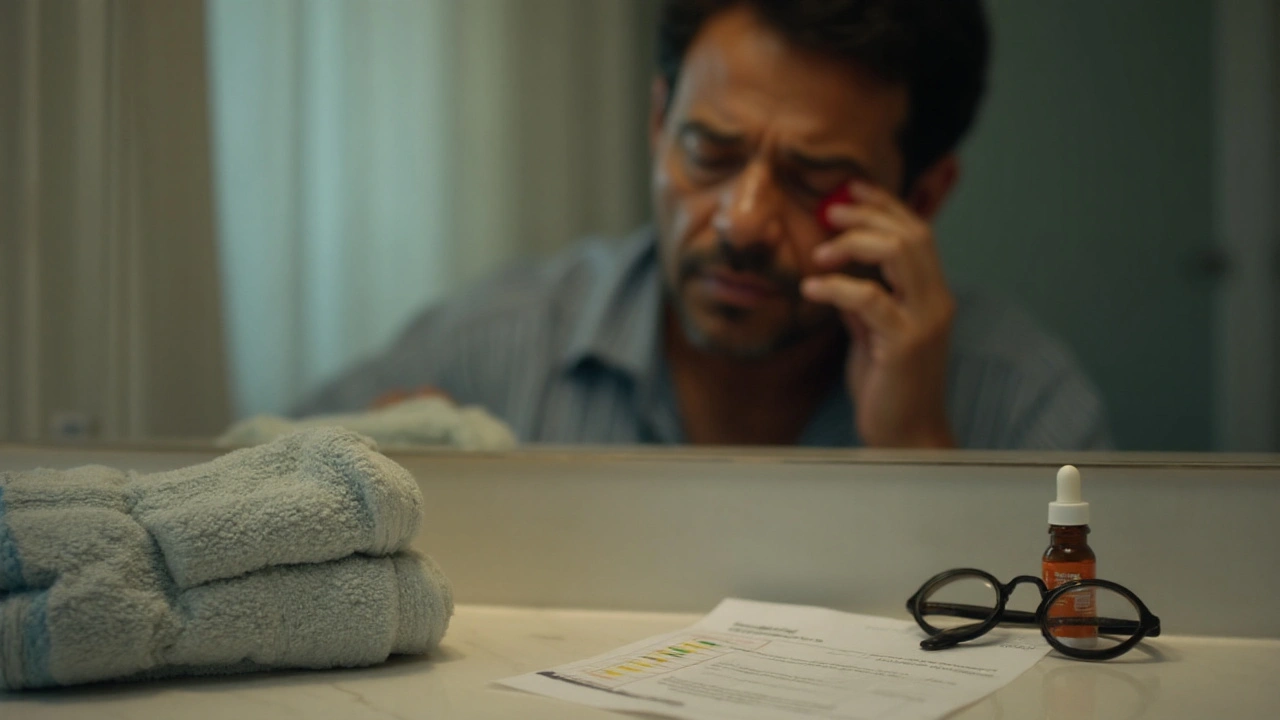Red, sticky eyes? You’re probably weighing up a quick course of chloramphenicol to get back to normal. Smart. But you want to be sure it’s the right bug, the right product, and that you won’t make things worse. This guide cuts through the noise: what chloramphenicol treats well, when to skip it, how to use it properly, and what to watch for. It also covers who should see a doctor fast (contact lens wearers-pay attention) and which alternatives make more sense for certain situations in Australia in 2025.
- TL;DR
- Chloramphenicol eye drops/ointment help many cases of bacterial conjunctivitis, but not viral or allergic causes.
- In Australia, ophthalmic chloramphenicol is Pharmacist Only (Schedule 3); systemic use is specialist territory due to rare, serious bone marrow toxicity.
- Use drops every 6 hours (more often at the start if severe) for 5-7 days; don’t use with contact lenses; see a doctor if no improvement in 48-72 hours.
- Red flags (pain, light sensitivity, reduced vision, trauma, contact lenses) need urgent assessment-don’t self-treat.
- Alternatives like fusidic acid, tobramycin, or fluoroquinolones may be better for specific bugs or contact lens users.
- You probably want to:
- Decide if your eye problem is likely bacterial and worth treating now.
- Choose between drops and ointment and know the right dose and duration.
- Avoid common mistakes that slow recovery or raise risks.
- Know when to switch tactics or see a clinician.
- Pick good alternatives if chloramphenicol isn’t a fit (contact lenses, pregnancy, recurrent infections).
What chloramphenicol is and how it works
What it is: Chloramphenicol is a broad-spectrum antibiotic that blocks bacterial protein synthesis by binding the 50S ribosomal subunit (peptidyl transferase inhibition). It hits common eye pathogens like Staphylococcus aureus, Streptococcus pneumoniae, and Haemophilus influenzae. It won’t reliably cover Pseudomonas aeruginosa, which matters for contact lens wearers.
Forms you’ll see in Australia (2025):
- Eye drops 0.5% (most common)
- Eye ointment 1% (handy overnight or for kids who fight drops)
- Systemic forms (capsules/injection) are prescription-only and rarely used here due to toxicity risks-kept for select severe infections under specialist care.
Regulatory status: The TGA lists ophthalmic chloramphenicol as Schedule 3 (Pharmacist Only Medicine). You can buy it after pharmacist assessment. Systemic chloramphenicol is Schedule 4 (Prescription Only).
Where it shines: Uncomplicated bacterial conjunctivitis-sudden-onset redness, gritty feel, mucopurulent discharge, eyelids stuck on waking, and no red flags. Many cases are self-limiting, but antibiotics can shorten symptom duration and time off work/school. A 2023 Cochrane review reported modestly faster clinical cure with topical antibiotics compared with placebo by day 5-7.
Where it’s not the hero:
- Contact lens-related red eye (worry for Pseudomonas-needs different coverage)
- Viral conjunctivitis (watery discharge, sandpaper feel, often after a cold)
- Allergic conjunctivitis (itch, both eyes, clear tearing, history of allergies)
- Red eye with real pain, photophobia, or reduced vision (think keratitis, uveitis, glaucoma-urgent review)
Evidence and guidance: The WHO Model List of Essential Medicines includes chloramphenicol (ophthalmic and systemic) for specific infections. Australian Therapeutic Guidelines (Antibiotic) back topical antibiotics for bacterial conjunctivitis in selected cases, and they highlight stewardship-don’t treat viral red eyes with antibacterial drops. The Royal Australian and New Zealand College of Ophthalmologists (RANZCO) flags red flags and the contact lens exception.
When to use it (and when to skip it)
Good candidates for chloramphenicol:
- One or both eyes red with mucopurulent discharge and lids stuck in the morning
- Gritty sensation rather than real pain
- No light sensitivity and no change in vision
- No contact lens use in the last week
- No history of corneal disease, recent eye surgery, or penetrating trauma
Don’t self-treat-see a clinician fast if any of these apply:
- Moderate to severe eye pain, photophobia, or noticeable vision drop
- Contact lens wear in the past week (remove lenses now and seek assessment)
- Corneal opacity/white spot, trauma, chemical splash, or foreign body
- Fever, rash, or joint pains with red eye (systemic process)
- Infants under 2 years old (OTC labels often exclude this group-needs medical review)
Viral vs bacterial vs allergic-quick heuristics:
- Viral: watery discharge, burning, recent cold, starts in one eye then spreads; preauricular node may be tender.
- Bacterial: thicker, yellow/green discharge, eyelids gluing on waking, often both eyes within 24-48 hours.
- Allergic: itch dominates, both eyes, stringy/clear discharge, seasonal or exposure triggers.
Special note for kids: Bacterial conjunctivitis is common. Pharmacies in Australia can supply chloramphenicol ophthalmic for children typically over 2 years after pharmacist assessment. For babies and toddlers under 2, see a GP or urgent care for diagnosis and dosing advice.
Pregnancy and breastfeeding: Topical ocular chloramphenicol has minimal systemic absorption. Australian Medicines Handbook and Therapeutic Guidelines consider short ophthalmic courses likely low risk when benefits outweigh risks. If you’re pregnant or breastfeeding, check with your GP or pharmacist first. Avoid systemic chloramphenicol late in pregnancy due to the risk of “grey baby syndrome.”

How to use drops and ointment (doses, steps, hygiene)
Typical dosing (adults and children ≥2 years, pharmacist-directed):
- Drops 0.5%: 1 drop every 6 hours for 5 days. For more severe discharge, you can start with every 2-4 hours while awake on day 1, then step down to every 6 hours.
- Ointment 1%: 1 cm ribbon into the lower eyelid every 6 hours for 5 days. Ointment blurs vision, so many people use it at night and drops during the day.
- Duration: continue for 48 hours after symptoms settle; if no improvement by 48-72 hours, get reviewed.
How to apply eye drops (step-by-step):
- Wash your hands. Don’t touch the dropper tip.
- Tilt head back, look up. Gently pull down the lower lid to form a pocket.
- Hold the bottle above the eye. Drop one drop into the pocket, not on the eyeball.
- Close your eye gently. Press the inner corner (near the nose) for 1 minute to reduce drainage into the nose/throat.
- Wait 5 minutes before a second drop or different eye medicine.
- Recap the bottle without touching the tip. Wash hands again.
How to apply ointment:
- Wash hands. Tip stays clean-don’t touch anything.
- Pull down the lower lid and lay a 1 cm ribbon into the pocket.
- Blink gently a few times. Vision may blur for 10-15 minutes.
Hygiene rules that speed recovery:
- Stop contact lenses immediately. Don’t restart until 24-48 hours after symptoms fully resolve and lenses have been cleaned/replaced.
- Wipe discharge with a clean tissue or cooled boiled water on cotton pads. One wipe per swipe, then toss.
- Don’t share drops, towels, pillowcases, or makeup. Replace eye makeup used during infection.
- Discard the bottle 28 days after opening (or sooner if the label says).
Using with other eye meds: If you’re on multiple drops, keep a 5-10 minute gap. Drops go in before ointments. If you use artificial tears, separate them by at least 5 minutes to avoid washing out the antibiotic.
Safety, side effects, and who should avoid it
Common and mild:
- Brief stinging or burning after application
- Temporary blurred vision (more with ointment)
- Unpleasant taste in the mouth (nasolacrimal drainage)
Allergy/irritation: If your eyelids swell, the whites turn angry red, or itching worsens after using drops, stop and get advice-this can be a hypersensitivity reaction.
Serious but rare: Chloramphenicol has a well-known risk of bone marrow suppression and aplastic anaemia with systemic therapy. Estimates for idiosyncratic aplastic anaemia after systemic exposure hover around 1 in 24,000-40,000 courses. With eye drops, systemic absorption is tiny, and only very rare case reports link ophthalmic use to bone marrow issues. Still, avoid long or repeated courses without medical oversight, and avoid if you’ve had previous chloramphenicol-associated blood dyscrasia.
Who should talk to a doctor first:
- History of bone marrow disorders or unexplained anaemia
- Severe liver disease
- Infants and toddlers under 2 years
- Pregnant or breastfeeding
- Recurrent conjunctivitis (more than twice in a few months)
Interactions: Topical ocular doses have minimal systemic effect, so interactions are rare. Systemic chloramphenicol (not the focus here) interacts with warfarin and some antiepileptics. If your INR is tightly managed or you’re on complex meds, check in with your GP or pharmacist.
Contact lens warning: Red eye in a contact lens wearer is not routine conjunctivitis until proven otherwise. Pseudomonas keratitis can threaten sight. Switch to a fluoroquinolone (e.g., ofloxacin) under medical guidance and get assessed promptly.
Evidence notes for safety: The risk profile and guidance here lean on Therapeutic Guidelines: Antibiotic (Australia, latest edition), the Australian Medicines Handbook (2024-2025), RANZCO clinical statements on red eye, and long-standing pharmacovigilance literature (the original link to aplastic anaemia was described by Wallerstein et al., with later population estimates and ophthalmic safety summaries by Fraunfelder and colleagues).

Alternatives, comparisons, and when to escalate care
Chloramphenicol is handy, but it’s not always the best tool. Pick based on likely bug, risk factors, comfort, and stewardship.
Quick picks:
- Fusidic acid: great for staph coverage; twice-daily dosing is easy, useful in kids.
- Tobramycin: better gram-negative activity, OK if you’re worried about non-staph bugs.
- Fluoroquinolones (ofloxacin, ciprofloxacin): go-to for contact lens wearers and suspected corneal involvement-strong Pseudomonas coverage.
- Polymyxin B/gramicidin combinations: alternative broad coverage, often well-tolerated.
Choosing between drops and ointment: Ointment lingers, which helps overnight coverage and dry-eye comfort; drops feel cleaner during the day. For kids who clamp eyelids, a quick wipe of ointment along the lashes at the inner corner lets a bit melt in with blinking.
| Option | Best for | Coverage highlights | Typical dosing (adult) | Contact lens suitability | Notes |
|---|---|---|---|---|---|
| Chloramphenicol 0.5% drops / 1% oint | Uncomplicated bacterial conjunctivitis | Staph, Strep, H. influenzae; not reliable for Pseudomonas | 1 drop q6h (q2-4h day 1 if needed) for 5-7 days; 1 cm oint q6h | No (seek fluoroquinolone + assessment) | Pharmacist Only in AU; avoid prolonged/repeat courses |
| Fusidic acid 1% (viscous drops) | Likely staph, dosing simplicity | Strong staph coverage | 1 drop q12h for 5-7 days | No | Good adherence in kids; limited gram-negative activity |
| Tobramycin 0.3% drops | Mixed flora or gram-negative concern | Staph, many gram-negatives (still variable) | 1-2 drops q4-6h for 5-7 days | Better, but still see clinician | Stings more than some; prescription in many cases |
| Ofloxacin 0.3% / Ciprofloxacin 0.3% drops | Contact lens wearers, corneal risk | Excellent Pseudomonas coverage | 1-2 drops q4-6h; loading then taper per prescriber | Yes (preferred) | Prescription; prompt review recommended |
When to escalate care:
- No improvement in 48-72 hours or worsening at any time
- Severe pain, light sensitivity, or vision change
- History of autoimmune disease, recent eye surgery, or trauma
- Contact lens use or corneal involvement suspected
Checklist: is chloramphenicol right for me today?
- Sticky discharge, gritty feel, lids glued on waking?
- No contact lenses for the last week?
- No pain or light sensitivity, and vision is fine?
- Age ≥2 years, not pregnant/breastfeeding-or you’ve checked with a clinician?
- Ready to follow hygiene steps and stop if symptoms worsen?
If you checked all boxes, chloramphenicol is a reasonable short course. If not, pause and get advice.
Mini‑FAQ
- How fast will it work? Many people feel less gritty within 24-48 hours. Discharge usually eases by day 2-3.
- Can I use it in both eyes? Yes, if both are symptomatic. Treat the worse eye last to avoid spreading more bugs.
- Can I drive? Wait until blurred vision clears after dosing (especially with ointment).
- What if I miss a dose? Use it when you remember, then carry on. Don’t double-dose.
- How long is the bottle good for? Discard 28 days after opening.
Next steps / Troubleshooting
- Office worker with a red, weepy eye: Start chloramphenicol if criteria fit, work from home for the first 24 hours if possible, avoid handshakes and shared keyboards.
- Parent of a 6‑year‑old: Choose drops by day and ointment at night. School can usually resume once the child feels better and discharge is minimal (confirm with your school’s policy).
- Contact lens wearer: Stop lenses now; don’t self‑treat with chloramphenicol; get seen and expect a fluoroquinolone if bacterial keratitis is suspected.
- Recurring redness every month: Ask for a review-blepharitis, meibomian gland dysfunction, or allergic disease may be the driver. You might need lid hygiene, warm compresses, or antihistamine/mast‑cell stabiliser drops instead of antibiotics.
- Pregnant or breastfeeding: Check with your GP/pharmacist first; short topical courses may be acceptable, but you want tailored advice.
Why stewardship matters: Many red eyes are viral or allergic. Saving antibiotics for true bacterial cases reduces resistance and keeps first‑line options effective. The WHO and Australian guidelines both push this message strongly in 2025.
Where this guidance comes from: Primary sources include Therapeutic Guidelines: Antibiotic (Australia, 2024-2025), the Australian Medicines Handbook (2024-2025), RANZCO red eye guidance, the WHO Model List of Essential Medicines (latest update), and the 2023 Cochrane Review on topical antibiotics for acute bacterial conjunctivitis.
